Age of Wonders 4 Review
As gamers, we’re often spoiled for choice. With so many titles coming out, it is impossible to play them all. We can narrow it down by sticking to specific genres or certain developers. If you like 4X strategy games or have been following Triumph Studios since 1999, then Age of Wonders 4 might be on your shortlist. Rest assured, it fits snugly into the genre and builds upon its excellent predecessors. In 2014, Age of Wonders III brought the series back after a long hiatus, and it was incredibly addictive and faithful. The spinoff, Planetfall, added more depth and a nice coat of sci-fi paint. The latest entry returns to the fantasy setting and puts emphasis on choice. Players are able to experience custom stories, make their own rulers, and explore a sea of worlds with various modifiers. And with some healthy changes to the formula, Age of Wonders 4 is a good turn-based strategy game that will have players enthralled for hours, despite its technical blemishes.
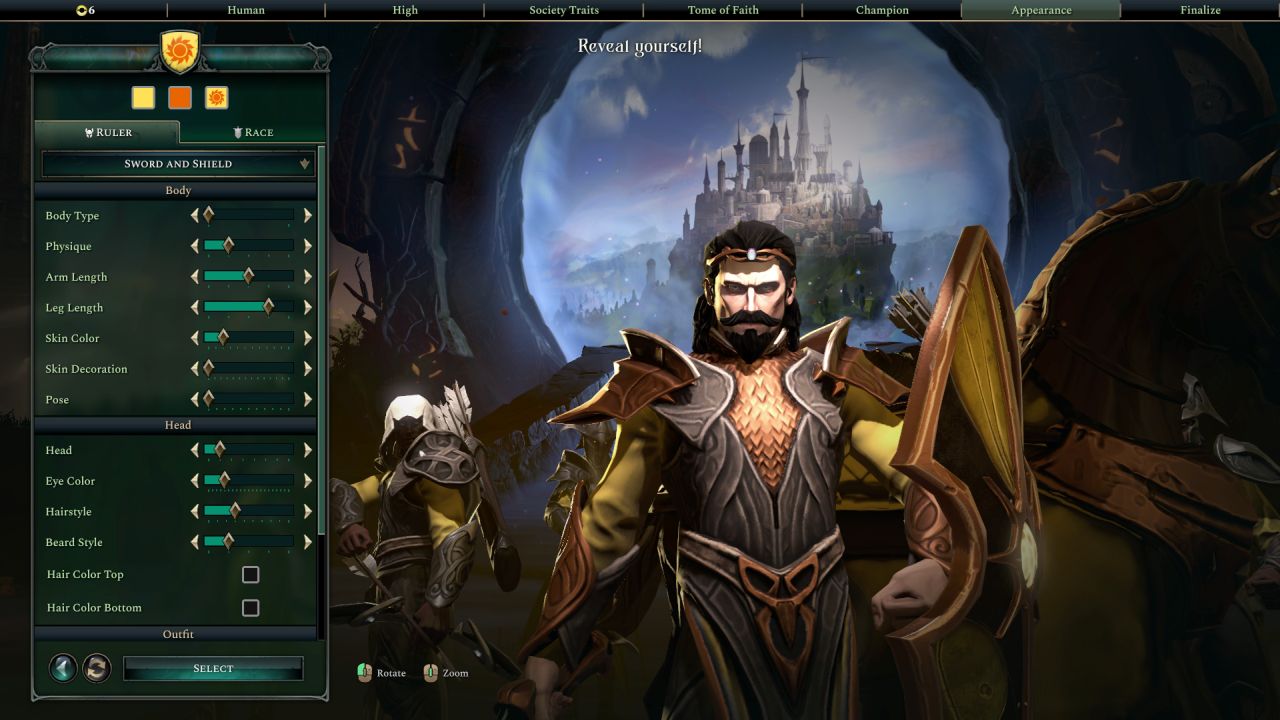
Age of Wonders 4 begins by introducing players to a place called Magehaven, which is a key part of the game’s somewhat confusing lore. Magehaven is basically a way station between an endless sea of worlds. Players become a ruler and step through a world gate into a randomly generated and unexplored realm. Rulers can be picked from a predefined list or created from scratch. Customization options for the 3D avatars are plentiful, with choices for race, armor, title, skin color, pose, and body type. You also must select starting spells and army traits, which provide resource perks, different combat abilities, and city production variations.
Realms provide nearly as much tantalizing customization. Like rulers, some have been setup with simple modifiers to get started immediately. Or, create a custom realm by picking a world biome, from desert to arctic, and change the distribution of resources or marauder enemy types. Add a modifier to transform the realm into small islands, or opt for a huge underground zone. One disappointment is the lack of control over map size, which is dictated by ruler count and a partially effective distance setting; but this means two rulers will never face-off on a huge map. Each time your chosen ruler travels to a custom realm, a brand new world is randomly stitched together, providing excellent replay value. And the more you play, the more customization is unlocked for both rulers and realms.
When you enter a realm, you start with a small army (featuring your ruler as a hero) and one city. Send the army to fight spiders loitering on a resource node. Direct a scout to claim a watchtower that reveals a subterranean passage. And build a food store in your city as you produce a basic combat unit. Then end your turn and wait for the other rulers and independents to sort themselves out. With every turn the decisions grow exponentially. In the following turn, your army might stumble on an infestation that will send out hostile skeletons until it is cleared. And your scout could reach the outskirts of a neutral city, allowing you to form an alliance via extensive negotiations and expensive gifts, or trespass to begin a war and claim the city for yourself.
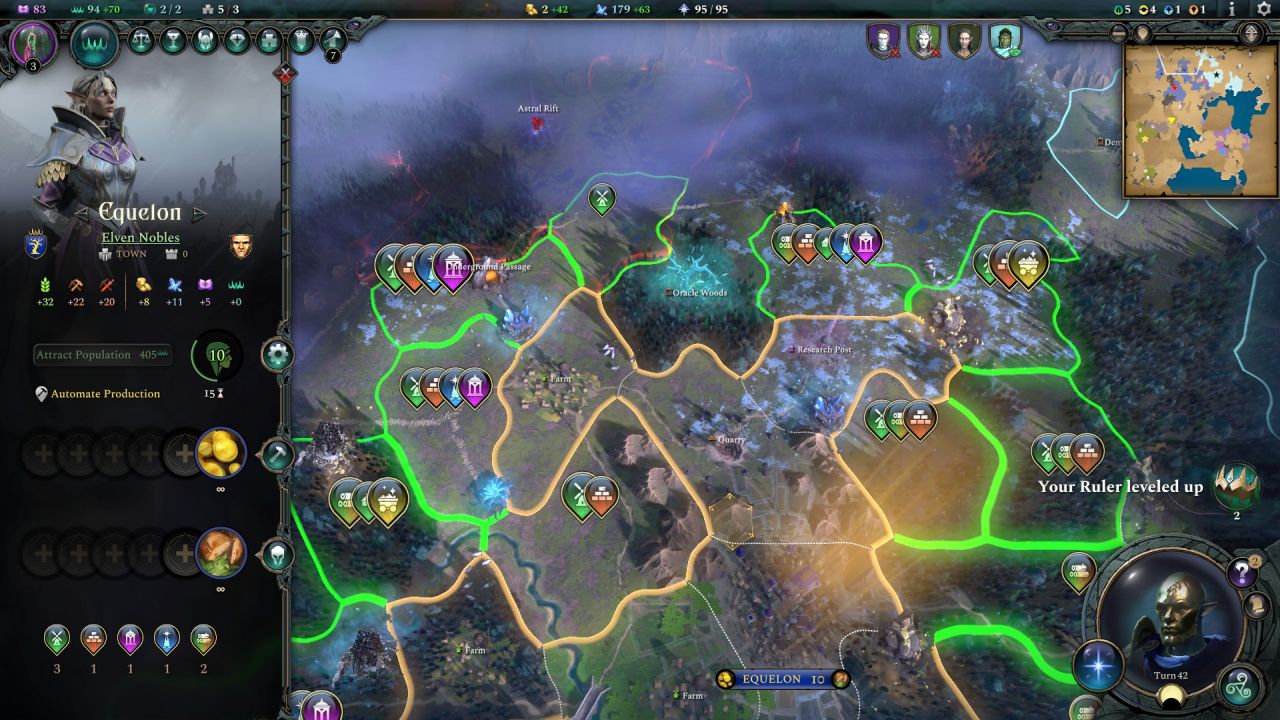
Gold and mana are the two main resources that keep your empire flourishing. They’re mainly used for construction, spells, and unit upkeep. In addition, each city has three isolated resources: food for population growth, construction for building speed, and draft for unit creation. Structures in cities will increase the income of one or more resource, further boosted by annexing adjacent provinces when your city grows. Provinces are smaller and more frequently unlocked than the ones in Planetfall, which offers great benefits and more empire choice, as well as creating roads for armies to travel farther on per turn. And later, special structures can be placed on province nodes to increase resource gain or add functionality, like with a teleporter.
If this sounds a lot to manage, never fear, the game is great at explaining things. There are hundreds of tooltips and a handy list of things that need your attention per turn. But managing a bunch of cities is not easy with so much going on. Fortunately both city building and expansion can be automated—although choosing a direction to expand your empire is too much fun to hand over to the AI. And combat units still need to be queued manually. Depending on the circumstances, you may have to pause reinforcements or negotiate with allies, to ensure your armies don’t fumble attacks when you cannot afford their upkeep. Cities can lose morale too, and become a resource drain, which could be when you throw in the towel and let them become independent. But you can remain friends with those same independents and leach off their income until you have the resources and know-how to try again.
They say knowledge is power and that is true when it comes to the magic tomes containing spells. Knowledge is another global resource that unlocks useful spells from a huge magic library. The first tome is preselected based on your chosen ruler, but after that you are free to mix and match. There are over 50 tomes with spells grouped together based on a theme, like fire magic or nature attunement. Learning these tomes also unlocks benefits on a large empire skill tree, like the ability to create roads or get more assistance from allies. Some spells from tomes are cast from the world map, and these might damage armies with an earthquake or boost a city’s production. A few spells buff units with poison damage or extra defense, with significant upkeep costs. Most tomes have spells that let you bring units directly onto the world map, which is handy to bolster armies or undertake sneaky scouting. Often the most fun spells are direct attacks that are deployed in the tactical battles.
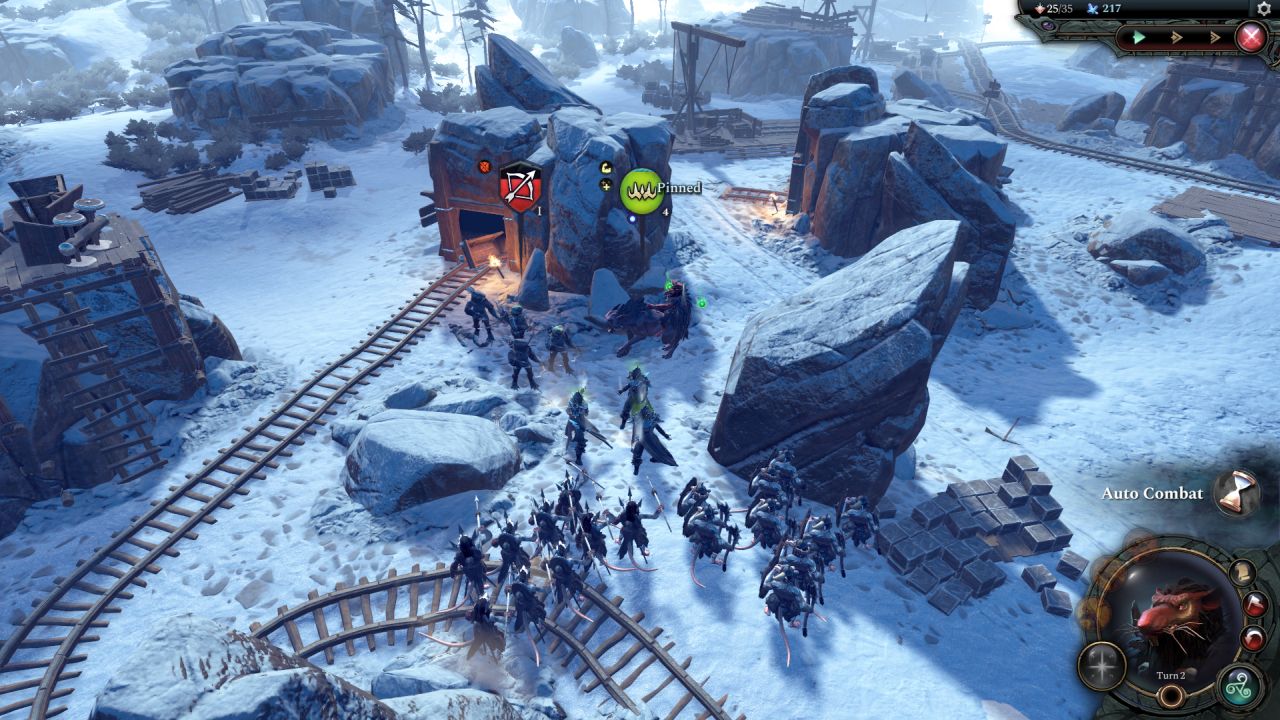
Tactical battles commence when armies clash on the world map. Taking place inside dedicated arenas, these involve three armies per side (each containing up to 6 units) gathered from up to three hexes away, which is different than before. In previous games, it was every army from adjacent hexes, which could theoretically mean 6v1. This method is probably better, because forces need not rub noses and battles are balanced. All tactical battles can be automated, which is time-efficient when the encounters are lopsided. But the automated result is not always optimal. In one underground battle against a spider posse, my three decent armies were annihilated. Retrying again in manual mode resulted in a decent win and enemies fleeing due to low morale.
The tactical battles are strategy rich and grow in depth as the heroes (typically army leaders) level up and acquire more skills or equipment from their conquests. Like previous games, individual units move on a hex grid with action points that dictate the number of melee or ranged attacks they can perform. Position, rotation, defensive stances, buffs, accuracy, arena-specific obstacles, and spells all play a huge role in the outcomes. Simple moves like sticking together, attacking in a specific order, or not charging in the first turn can win the day. And preparing for the next turn is always smart. For people that like complexity, tactical battles offer it in spades.
Manually controlling tactical battles is best when there are about 8 units per side. Much more than that and it is easy to suffer choice paralysis and hard to understand how the battle is progressing until near its conclusion. Full manual battles are also slow, as each side’s 18 units move and attack or buff themselves. That said, you can switch on and off the automate feature in manual mode as well. Taking control intermittently, to use combat spells or deploy a specific strategy, is a good compromise. But the smaller battles are fun to fully control because you can optimize outcomes and protect injured units, without investing too much time or mental energy.
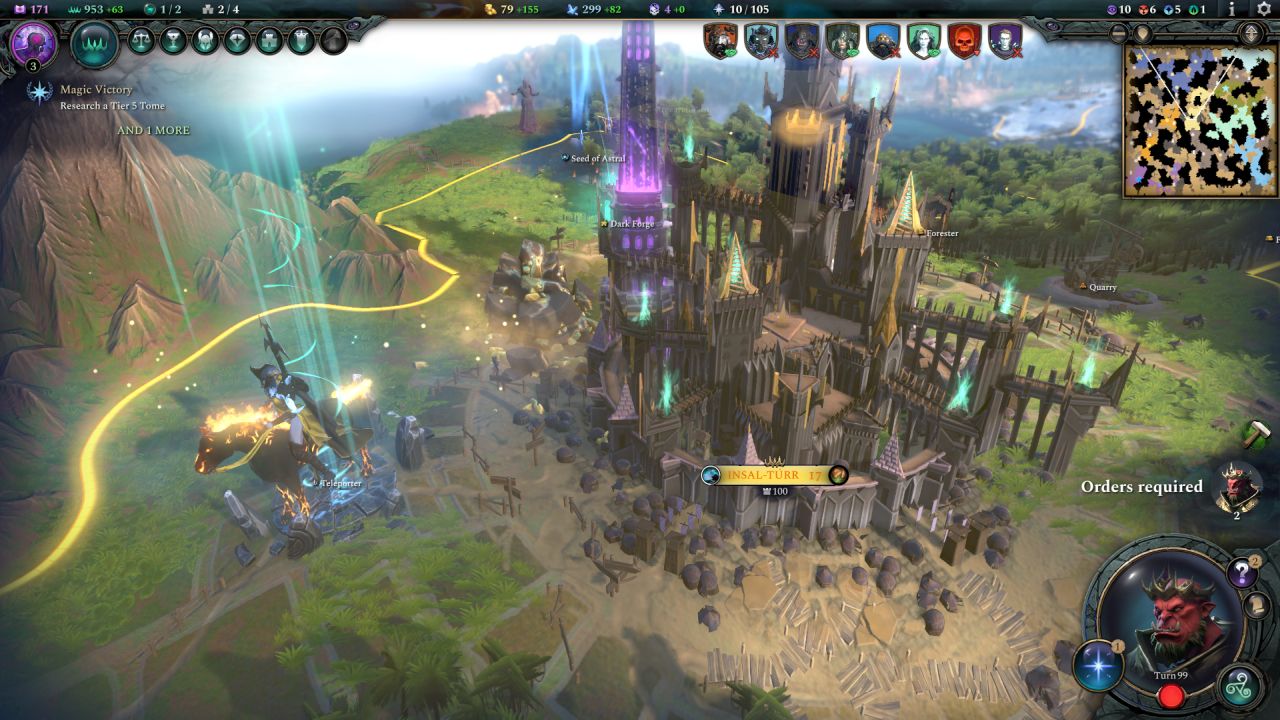
After picking your battles and fighting to an enemy ruler’s throne city, it is time to begin a siege. These sieges are new to the franchise but not complicated. They’re basically a delayed tactical battle as your army sets fire to a city and waits to breach its defenses. This breaching typically takes 3 to 5 turns on the world map, giving defenders a chance to return home or produce more units. Attackers can setup siege projects, which damages walls (aiding movement during battle) and reduces siege time, thereby minimizing the chance of help arriving. While the attacking hero must stay inside the city’s zone, others can breakaway and sit on province nodes to reduce income.
The idea of sieges is to change that frustrating endgame where the enemy AI places a heap of armies on their city. At the very least the sieges means the defenders don’t need to turtle, as long as they’re close enough or have a spell that can bring them back quickly. The downside is that attackers might not know what hell they’re walking into, and may have to retreat if powerful armies come around the corner. Sieges are an improvement, but the endgame is still like musical chairs, because attacking armies pillage provinces and encircle, just with more distance between chairs and days before everybody sits down.
Destroying the enemy through military conquest isn’t the only way to hear the victory music. Expansion victories occur when a ruler has grown their empire large enough to annex dozens of provinces, before placing beacons that must be lit. Magical victories rely on the ruler learning high-level spell tomes and placing special affinity buildings inside their provinces. Both approaches then involve protecting the newly created structures from respawning incursions over 15 turns. And since they are more defensive and peaceful routes, they’re a great contrast to a purely militant option.
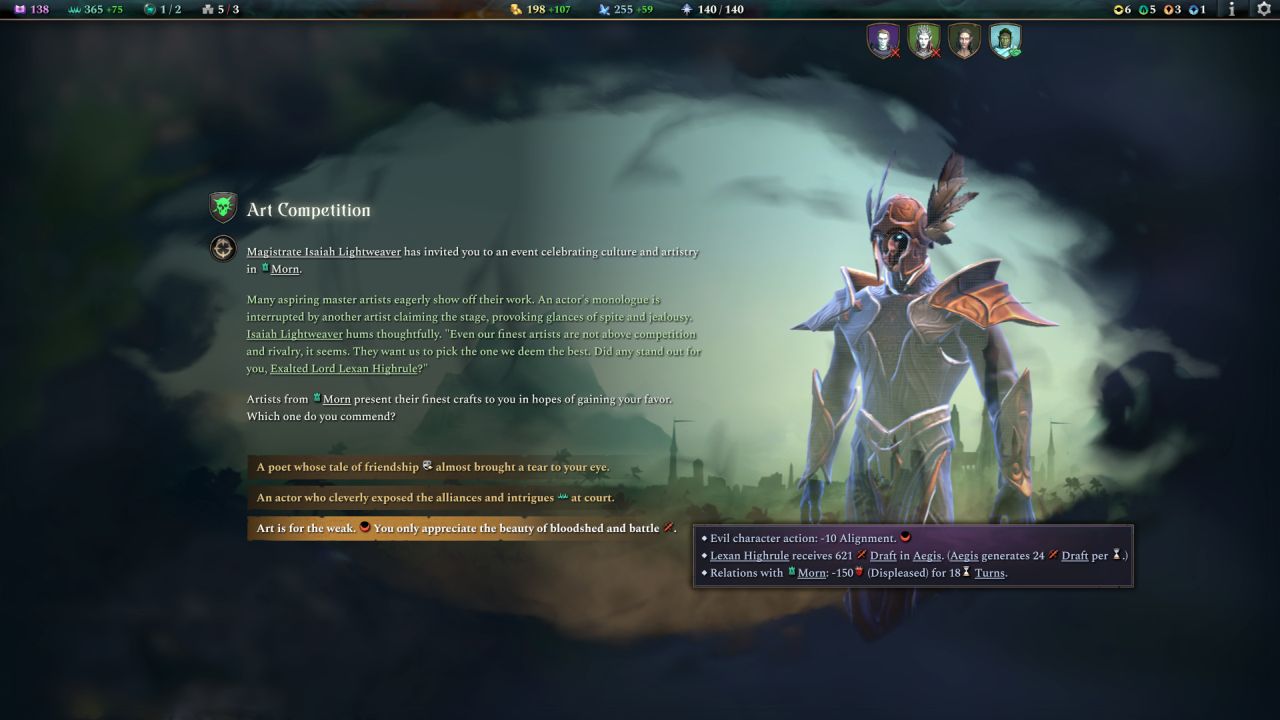
The path to any victory is paved with mini-stories thanks to the game’s dynamic narrative content. Every so often, people of your own city or allied free cities will cause a random story event to pop up. This could be your constituents wanting more knowledge or an ally asking for help to hunt monsters. You then have a few ways to handle it, which typically alters what resources or alliances are gained or lost, and maybe a change in alignment from good to evil. These story pop-ups are sometimes funny (like when civilians asked for a third breakfast) and usually bring a nice change to the steady grind. If they were more connected, with deeper choice and consequence, they could have been even better.
If you want more significant story then there are five dedicated story realms that form a campaign. They dive further into the lore of Magehaven and the ‘astral sea’ of worlds, as a hostile faction seeks to break the status quo. Most story realms are large missions that feature many rulers and unaffiliated cities. Although you can play as any custom ruler, story realms cannot be altered but are still randomized. They typically feature unique story quests, like casting spells to reveal weaknesses. In two campaign missions, you effectively become the bad guy, and can choose to roleplay as an evil ruler. The mission around a lava caldera is fantastic, and most others are enjoyable. However, the finale with 9 rulers (and several hostile independents) is a colossal slog, and it took a few attempts to clear. Players might get around 40 hours out of the campaign, depending on victory conditions and how often tactical battles are simulated.
Whether you play the campaign or random realms, Age of Wonders 4 looks amazing. Tactical battle arenas do repeat a few times over a game, but their design links to the world hex so there is quite a lot of variety. It might be subtle changes like the ground being sand instead of grass or entirely new tombs found in ancient wonders. Units in the armies are diverse and detailed, from druids and dragons to fairies and frogs, even changing their appearance when buffs are applied. The biggest visual eyesore for tactical battles is the sea combat; all units become boats and ram each other for their melee attacks. Fortunately the world map is always gorgeous, with a nice tilt-shift effect when zooming close. The bright colors provide tremendous contrast and it is a joy to see cities add individual components as they grow bigger. As empires expand, tiny mine carts enter and exit gold nodes like cuckoo clocks and farms with windmills spill across the countryside like in a storybook. The music is, once again, inspiring in the same vein as its orchestral predecessors.
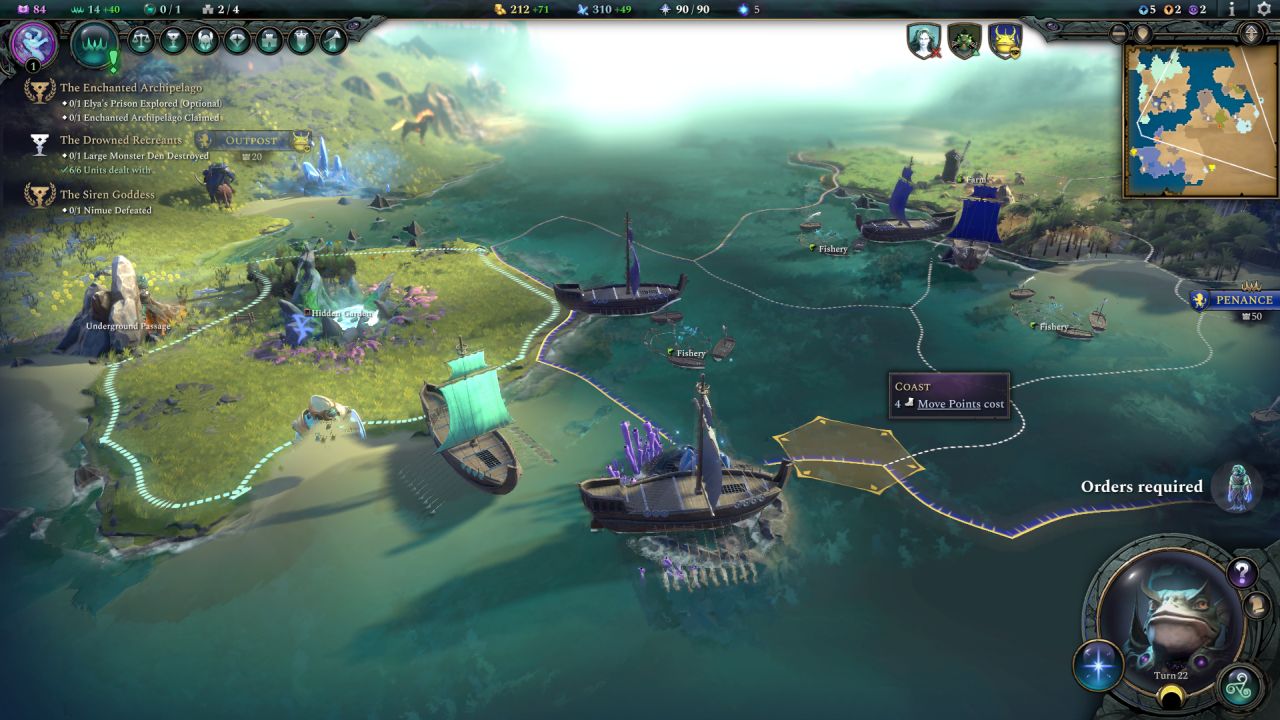
Despite all the wonderful content, Age of Wonders 4 is a bit of a mess technically. Performance can drop badly in tactical combat. It was common to see 20-25 frames-per-second, even on the lowest visual settings, during full battles—another reason why smaller battles are better. Even waiting for the AI to move can send the framerate to zero for seconds. The final story realm was incredibly unstable; it crashed a dozen times, over nearly as many hours, and once the AI enemies just refused to move. The UI broke a few times, with unit pictures going whacky, army banners rendering incorrectly, buttons not working, and menus vanishing all together. Some armies did not obey move orders, stopping halfway until one of those story pop-ups eventually appeared. Even selecting a low difficulty for some realms resulted in very hard AI opponents appearing, but at least you can dive into the advanced settings to rectify this. Given the number of crashes and weird problems, it is a good thing the game autosaves after every turn.
It is not surprising that the multiplayer is a bit unstable too. The online component supports up to nine rulers (humans or AI) on custom realms, with various gameplay settings. Create teams, put on a turn-timer, disable the manual combat, increase the game speed, and give good players handicaps. However, it’s not that easy to even begin a game. There is a list of public sessions but the vast majority have inactive hosts. Plus, some sessions cannot even be joined. If you manage to find players, the multiplayer works okay, albeit with huge waits when other rulers perform combat or make decisions. So if you do crash out, it is possible to rejoin before others have ended their turn. One unique problem with online games is that they tend to get out of sync, like when a story pop-up got stuck in an infinite loop. While the desync usually fixes itself, sometimes it requires players to exit the game. With patience, you can have fun with friends in multiplayer, but waiting for a few patches could save a few headaches.
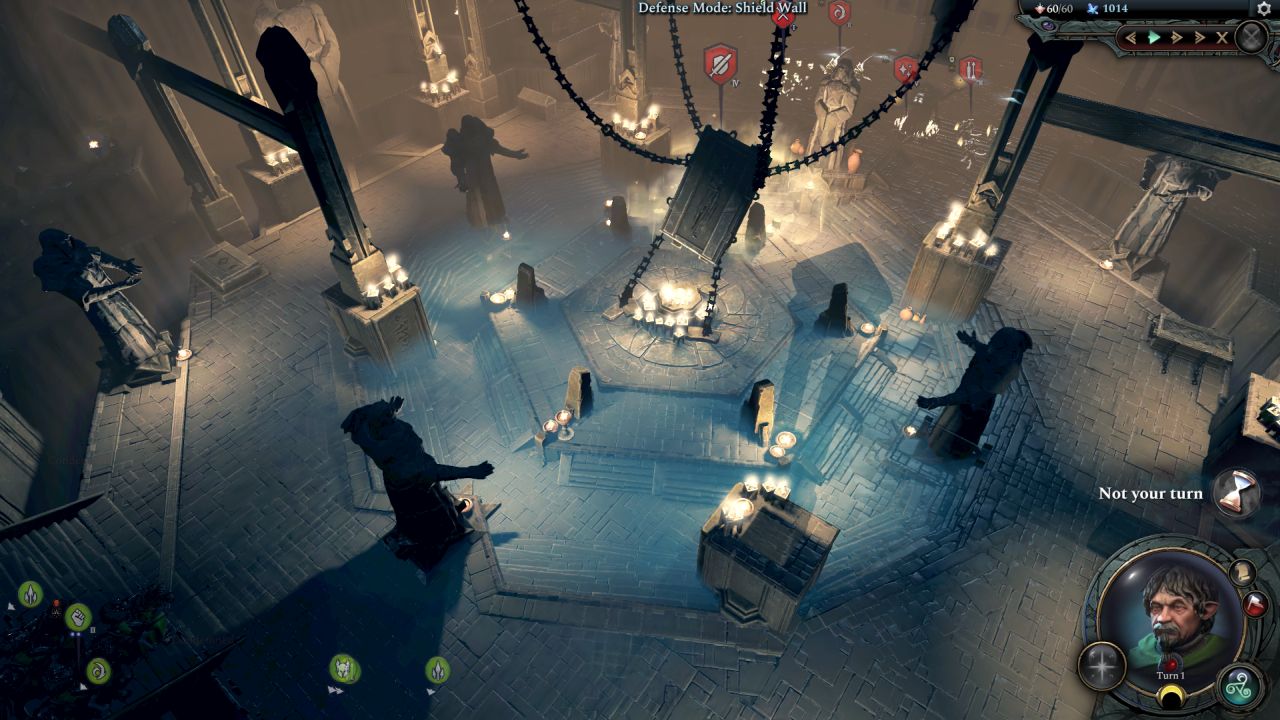
Despite some disappointing technical issues and a wonky multiplayer component, Age of Wonders 4 is an enjoyable turn-based strategy game that builds on its predecessors’ successes. It looks fantastic with great visual contrast thanks to a storybook world and glorious fantasy units. The campaign is enjoyable because of fun missions, despite an arduous finale. Even the dynamic story content will keep turns from stagnating within custom realms. Sieges and alternate victory conditions reduce army stacking and loosen the shackles, although military power is still important. Tactical battles are satisfying when unit numbers are small, and simulated fights produce acceptable outcomes. And let us not forget the myriad of options to build custom realms and create unique rulers. With such good replay value, Age of Wonders 4 is a portal to spoils beyond this world and the next.
